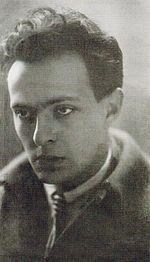(LAT) Šis slēpnis ietilpst slēpņu sērijā “Ludzas cilvēki”. Slēpnis veltīts ebreju izcelsmes padomju māksliniekam - supremātisma pārstāvim Iļjam Čašņikam. Slēpnis ir PET konteineris, kurā ievietota viesu grāmata. (BYOP)
(ENG) This cache belongs to the series of geocaches “People of Ludza”. The cache is dedicated to suprematist artist Ilya Grigorevich Chashnik. The cache is a PET container containing a guestbook. (BYOP)
(LAT)

Iļja Čašņiks (krieviski: Илья Григорьевич Чашник; dzimis 1902. gada 13. jūnijā, miris 1929. gada 4. martā) bija Ludzā dzimis ebreju izcelsmes padomju mākslinieks - supremātisma pārstāvis. Kazimira Maļeviča skolnieks un viens no UNOVIS skolas dibinātājiem. Plaši pazīstamo apvienību UNOVIS dibināja Kazimirs Maļevičs 1920.gadā. Savulaik UNOVIS strādāja arī citi pazīstami mākslinieki no Latvijas - Gustavs Klucis, Jānis Tīlbergs.
Dzimis Ludzā, ebreju ģimenē. Drīz pēc Iļjas dzimšanas ģimene pārcēlās uz guberņas centru Vitebsku. Vienpadsmit gadu vecumā uzsāka darbu mehānikas-optikas darbnīcā. 1917. gadā sāka apmeklēt mākslas skolu Vitebskā, kur pirms viņa mācījās Marks Šagāls. Mācījies pie tādiem māksliniekiem kā Kazimirs Maļevičs, Marks Šagāls, Els Ļisickis. 1922. gadā pārcēlās uz Petrogradu, kur 1929. gadā miris. Uz mākslinieka kapa tika uzstādīts piemineklis: balts koka kubs ar melnu kvadrātu.
Iļja Čašņiks attīstīja sava skolotāja Kazimira Maļeviča idejas, radot apjomā nozīmīgus bezpriekšmetu glezniecības un grafikas darbus, un uzskatījā sevi par Maļeviča pilnīgu domubiedru. Pilnībā pielietoja savos darbos supremātisma principus, savu krāsu gammā lietojot balto, melno, sarkano un gaiši zilo krāsu.
Mākslinieka atpazīstamākie darbi: Supremātisms (1923, Tretjakovas galereja), Supremātiskā kompozīcija (1923, Tissena-Bornemisa muzejs, Madride), Kompozīcija (1925-1926, Ludviga muzejs, Ķelne).
 Supremātisms (1923)
Supremātisms (1923)
Čašņika visdārgāk pārdotais darbs ir “Septīta dimensija, supremātiskais reljefs” (1920), kas 2016. gada 30. novembrī tikā pārdota par 2,4 milj, mārciņām (aptuveni 3 milj. EUR).
(ENG)
Ilya Grigorevich Chashnik (1902 - 1929) was a suprematist artist, a student of Kazimir Malevich and one of founders of the UNOVIS school.
He was born into a humble Jewish family in Lucin (now Ludza) and spent his childhood in Vitebsk, where he was introduced to the world of painting by a local artist.
Chashnik moved to Moscow in 1919 to further his artistic training at the Higher State Art-Technical-Studios (Vkhutemas) in Moscow, but his attraction for the work of Marc Chagall spurred him to return to Vitebsk after a few months to attend the art school he directed. During the winter of 1919–20, Malevich and a group of students formed the group known as Unovis (Affirmers of the New Art). Among those involved in the initiative was also Ilya Chashnik. He developed his own style within the Suprematist idiom, evolving from Malevich’s white compositions to paintings in which black was the predominant element. In these works geometric shapes form crossing planes with a tendency towards rhythm and symmetry.
After graduating in Vitebsk in 1922, he moved to Petrograd (now Saint Petersburg), where Malevich and other artists belonging to Unovis were already living. During this period Chashnik concentrated on exploring the possible applications of Suprematism in daily life: he designed textiles, posters and buildings and worked with Suetin in the Lomonossov factory. He began to collaborate with the Institute of Artistic Culture (Inkhuk) in 1923 and from 1925 with the Institute of Decorative Arts.
Chashnik was notably able in a variety of media. Aleksandra Semenovna Shatskikh describes him as "famous for his inexhaustible inventiveness and ability to apply Suprematist principles to virtually all forms of art, including easel painting." He painted, was proficient in metalwork, and designed ceramics produced at the Imperial Porcelain Factory (then known as the Lomonosov Porcelain Factory).He died in 1929 in Leningrad, at the age of 27.